The Intel Xeon W Review: W-2195, W-2155, W-2123, W-2104 and W-2102 Tested
by Ian Cutress & Joe Shields on July 30, 2018 1:00 PM EST- Posted in
- CPUs
- Intel
- Xeon
- Workstation
- ECC
- Skylake-SP
- Skylake-X
- Xeon-W
- Xeon Scalable
Benchmarking Performance: CPU Encoding Tests
One of the interesting elements on modern processors is encoding performance. This includes encryption/decryption, as well as video transcoding from one video format to another. In the encrypt/decrypt scenario, this remains pertinent to on-the-fly encryption of sensitive data - a process by which more modern devices are leaning to for software security. Video transcoding as a tool to adjust the quality, file size and resolution of a video file has boomed in recent years, such as providing the optimum video for devices before consumption, or for game streamers who are wanting to upload the output from their video camera in real-time. As we move into live 3D video, this task will only get more strenuous, and it turns out that the performance of certain algorithms is a function of the input/output of the content.
All of our benchmark results can also be found in our benchmark engine, Bench.
7-Zip 9.2
One of the freeware compression tools that offers good scaling performance between processors is 7-Zip. It runs under an open-source licence, is fast, and easy to use tool for power users. We run the benchmark mode via the command line for four loops and take the output score.
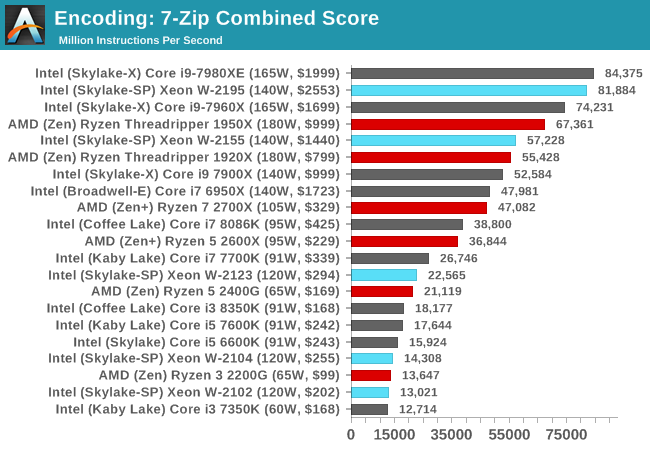

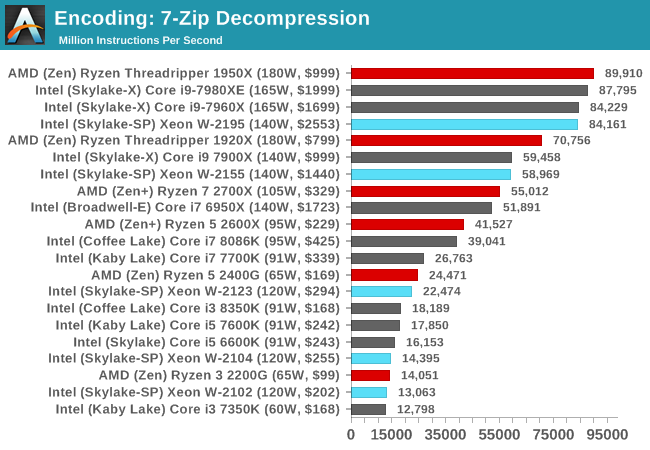
AMD's prowess in decompression means that it takes the top spot, however overall the W-2195 and the i9-7980XE are competing for top spot.
WinRAR 5.40
For the 2017 test suite, we move to the latest version of WinRAR in our compression test. WinRAR in some quarters is more user friendly that 7-Zip, hence its inclusion. Rather than use a benchmark mode as we did with 7-Zip, here we take a set of files representative of a generic stack (33 video files in 1.37 GB, 2834 smaller website files in 370 folders in 150 MB) of compressible and incompressible formats. The results shown are the time taken to encode the file. Due to DRAM caching, we run the test 10 times and take the average of the last five runs when the benchmark is in a steady state.
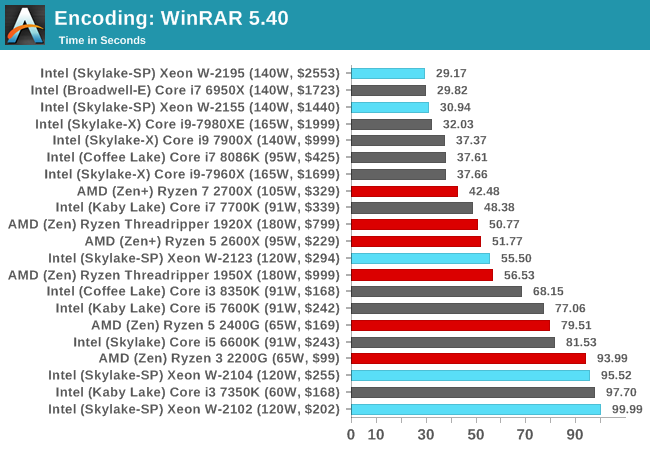
WinRAR likes cores and memory, and it seems that even the W-2155 can win against the Core i9-7980XE in this test. Despite the quad channel memory for the Xeon W quad core parts, the low frequency means they are bringing up the rear. The W-2123 hits mid-pack, actually beating the Threadripper 1950X in this test.
AES Encoding
Algorithms using AES coding have spread far and wide as a ubiquitous tool for encryption. Again, this is another CPU limited test, and modern CPUs have special AES pathways to accelerate their performance. We often see scaling in both frequency and cores with this benchmark. We use the latest version of TrueCrypt and run its benchmark mode over 1GB of in-DRAM data. Results shown are the GB/s average of encryption and decryption.

HandBrake v1.0.2 H264 and HEVC: link
As mentioned above, video transcoding (both encode and decode) is a hot topic in performance metrics as more and more content is being created. First consideration is the standard in which the video is encoded, which can be lossless or lossy, trade performance for file-size, trade quality for file-size, or all of the above can increase encoding rates to help accelerate decoding rates. Alongside Google's favorite codec, VP9, there are two others that are taking hold: H264, the older codec, is practically everywhere and is designed to be optimized for 1080p video, and HEVC (or H265) that is aimed to provide the same quality as H264 but at a lower file-size (or better quality for the same size). HEVC is important as 4K is streamed over the air, meaning less bits need to be transferred for the same quality content.
Handbrake is a favored tool for transcoding, and so our test regime takes care of three areas.
Low Quality/Resolution H264: Here we transcode a 640x266 H264 rip of a 2 hour film, and change the encoding from Main profile to High profile, using the very-fast preset.
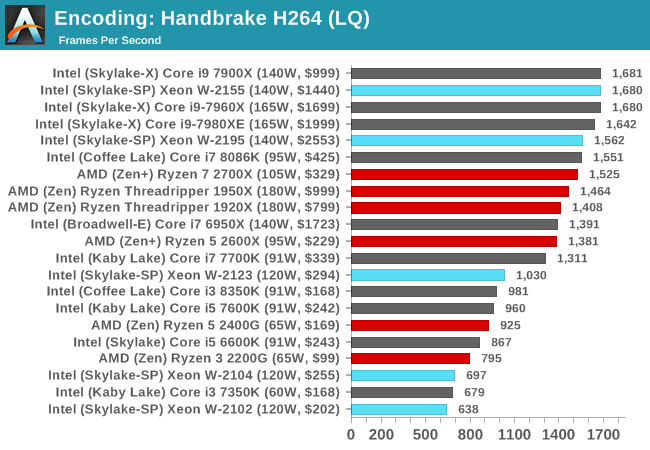
High Quality/Resolution H264: A similar test, but this time we take a ten-minute double 4K (3840x4320) file running at 60 Hz and transcode from Main to High, using the very-fast preset.
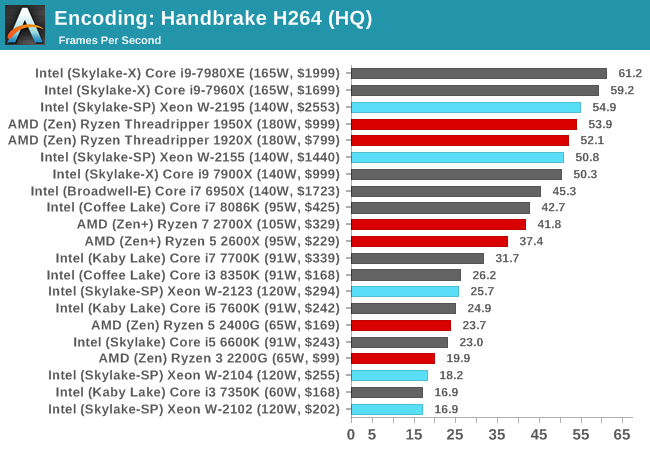
HEVC Test: Using the same video in HQ, we change the resolution and codec of the original video from 4K60 in H264 into 4K60 HEVC.
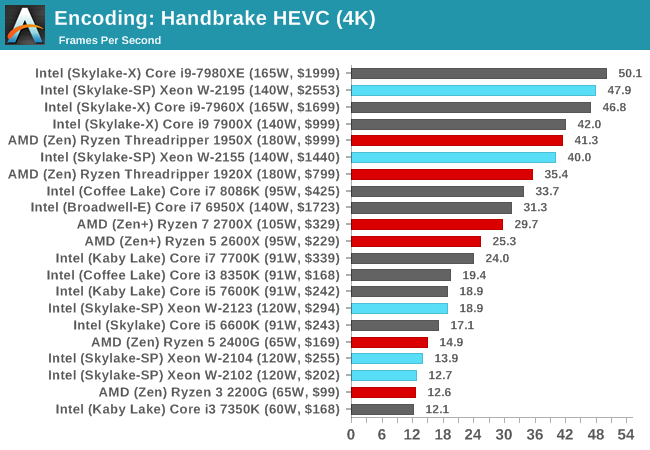










74 Comments
View All Comments
mode_13h - Monday, July 30, 2018 - link
Just the fact that you need to map your VMs to stay on the same physical core, for best performance (i.e. so that the memory is local to it). If you do that, TR is actually a great VM solution.Death666Angel - Monday, July 30, 2018 - link
That doesn't sound so complicated as to be a "situation" for someone dealing with VMs. :) Seems like a general setup config thing that you just check off when you do it once.mode_13h - Tuesday, July 31, 2018 - link
Sorry, I meant "same physical die". Actually, best results are from setting affinity at the CCX (i.e. 4-core) granularity.SanX - Tuesday, July 31, 2018 - link
The day ARM announced it developed 8 and 16-core server and supercomputer chips at their usual price around $25 per 5 billion transistors, Intel Xeon prices would plunge 10-50x.Infy2 - Monday, July 30, 2018 - link
It would be helpful on those charts if there was an indicator how many cores/threads in CPU has.Ian Cutress - Monday, July 30, 2018 - link
We used to have that info in the graphs, however people found it redundant when it was elsewhere, and price/power was requested instead. It's hard to put all the info of every part into every graph!Death666Angel - Monday, July 30, 2018 - link
Can that not be coded as a tooltip/mouse-over text? That would be neat and not add clutter while adding information to those who want it. :)Ian Cutress - Monday, July 30, 2018 - link
Graphs are images generated locally from the data. I'm not au fait with how our back end works, but that's require more than a simple rewriteDeath666Angel - Tuesday, July 31, 2018 - link
Alright. :) Shame though, would be a useful feature for some. Maybe add it to an overhaul list, if such a thing exists. :)lkuzmanov - Tuesday, July 31, 2018 - link
I'm with Infy2 on this one, not sure who protested, but I think something like (10/20) next to the model wouldn't be too distracting or cost too much screen space. I caught myself having to go back to the first page of the article to check the core count of the Xeon parts. That said - great content, you're one of my daily go-to sites.